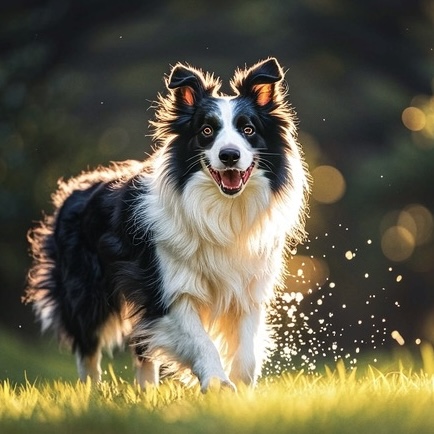
by TCMVET | May 27, 2024 | Dog Cancer & Tumors
Mast cell tumors (MCTs) are among the most common types of skin cancer in dogs. They can vary widely in their behavior, from benign growths to highly aggressive cancers that spread rapidly. The decision of when to stop fighting a mast cell tumor in a beloved pet is one of the most challenging and heart-wrenching dilemmas a pet owner can face. This article aims to provide a comprehensive guide to understanding mast cell tumors, treatment options, and the critical factors to consider when making this difficult decision.
Understanding Mast Cell Tumors
Mast cells are a type of white blood cell involved in allergic reactions and inflammation. When these cells form tumors, they can appear as lumps on the skin or under the skin. Mast cell tumors are graded based on their appearance under a microscope, which helps predict their behavior and guide treatment. The three grades are:
- Grade I (low grade): These tumors are generally well-differentiated and have a low potential for spreading.
- Grade II (intermediate grade): These tumors have a moderate potential for spread and may behave unpredictably.
- Grade III (high grade): These tumors are poorly differentiated, aggressive, and have a high likelihood of spreading to other parts of the body.
Treatment Options
Treatment for mast cell tumors can include surgery, chemotherapy, radiation therapy, and targeted therapies. The choice of treatment depends on the tumor’s grade, location, size, and whether it has spread. Common approaches include:
- Surgical Removal: Often the first line of treatment, especially for Grade I and some Grade II tumors. Complete excision with wide margins can be curative.
- Chemotherapy: Used for high-grade tumors or when surgery is not feasible. It can help control the disease and slow its progression.
- Radiation Therapy: Often used post-surgery if the tumor margins are not clean or for tumors in difficult-to-operate locations.
- Targeted Therapies: Drugs like tyrosine kinase inhibitors (e.g., Palladia) target specific pathways in cancer cells and can be effective for treating MCTs.
Factors to Consider
When evaluating whether to continue treatment or stop fighting the tumor, several factors need to be considered:
1. Quality of Life
The primary consideration should always be the dog’s quality of life. Symptoms of mast cell tumors can include pain, itching, swelling, and gastrointestinal issues due to histamine release. Owners should assess their dog’s comfort, happiness, and ability to perform normal activities. If treatments are causing significant discomfort without substantial improvement, it may be time to reconsider ongoing aggressive treatments.
2. Treatment Efficacy
Evaluate how well the treatments are working. If the tumor is not responding to treatment or continues to spread despite aggressive interventions, the likelihood of achieving a good outcome diminishes. At this point, continuing treatment may only prolong suffering without improving the quality of life.
3. Age and Overall Health
Older dogs or those with other significant health issues may not tolerate aggressive treatments well. In such cases, the risks and side effects of treatment may outweigh the potential benefits. A holistic view of the dog’s overall health and longevity should guide decision-making.
4. Financial Considerations
Treating mast cell tumors can be expensive, involving surgery, chemotherapy, and ongoing medications. Owners must realistically assess their financial ability to continue treatment and balance it with the expected outcomes.
5. Emotional and Ethical Considerations
The emotional toll on the family is significant. Owners should consider their emotional readiness to handle prolonged treatment and the potential loss of their pet. Ethical considerations also come into play, as owners must weigh the desire to prolong their pet’s life against the potential for prolonged suffering.
Palliative Care and Hospice
When the decision is made to stop fighting the tumor, focus shifts to palliative care. The goal is to maintain the best quality of life for as long as possible. Palliative care can include pain management, anti-inflammatory drugs, and medications to control symptoms like itching and gastrointestinal distress. In some cases, hospice care may be appropriate, providing comfort and dignity in the pet’s final days.
Conclusion
Deciding when to stop fighting a mast cell tumor in a dog is profoundly personal and challenging. It requires a careful evaluation of the dog’s quality of life, the effectiveness of treatments, and the overall well-being of both the pet and the owner. Consulting with a trusted veterinarian, seeking second opinions, and leaning on support networks can provide guidance and comfort during this difficult time. Ultimately, the decision should center on what is in the best interest of the beloved pet, ensuring their remaining time is filled with love, comfort, and peace.

by TCMVET | May 27, 2024 | Food & Health
Boswellia, also known as Indian frankincense, is a natural resin extracted from the Boswellia serrata tree. Renowned for its potent anti-inflammatory and antioxidant properties, Boswellia has been used for thousands of years in traditional medicine. Recently, it has gained popularity in pet care, especially for treating arthritis and other inflammatory conditions in dogs. This article explores the benefits of Boswellia for dogs, how to use it safely, and what to consider when choosing the best Boswellia supplements for your furry friend.
What is Boswellia?
Boswellia is a resin derived from the Boswellia serrata tree. It contains active compounds, such as boswellic acids, which have been shown to possess powerful anti-inflammatory and pain-relieving properties. These benefits make Boswellia an excellent natural alternative for managing joint health and reducing inflammation in dogs.
Benefits of Boswellia for Dogs
- Anti-Inflammatory Effects
- Arthritis Relief: Boswellia is particularly effective in reducing the inflammation and pain associated with arthritis. Regular use can help improve mobility and overall quality of life for dogs suffering from joint issues.
- Inflammatory Bowel Disease (IBD): Boswellia can help manage symptoms of IBD in dogs by reducing intestinal inflammation and promoting digestive health.
- Antioxidant Properties
- Cell Protection: The antioxidants in Boswellia help neutralize free radicals, protecting cells from oxidative stress and supporting overall health.
- Respiratory Health
- Breathing Support: Boswellia can help reduce inflammation in the respiratory tract, making it beneficial for dogs with bronchitis or asthma.
How to Use Boswellia for Dogs
- Oral Supplements
- Tablets or Capsules: Boswellia supplements are commonly available in tablet or capsule form. These can be given directly to your dog according to the veterinarian’s recommended dosage.
- Powder: Boswellia powder can be mixed with your dog’s food, making it easy to incorporate into their daily diet.
- Topical Application
- Boswellia Oil: Diluted Boswellia oil can be used to massage your dog’s joints, providing localized relief from pain and inflammation. Ensure the oil is properly diluted and monitor your dog to prevent licking.
Choosing the Best Boswellia Supplement for Dogs
- High Quality and Purity
- Opt for pure, natural Boswellia supplements without added fillers or artificial ingredients. High-quality products ensure your dog receives the full benefits of Boswellia.
- Third-Party Testing
- Look for supplements that have been third-party tested for purity and potency. This certification provides assurance of the product’s safety and effectiveness.
- Dosage and Formulation
- Choose a supplement formulated specifically for dogs, with appropriate dosages based on your dog’s weight and health condition. Consult your veterinarian for personalized dosage recommendations.
Precautions and Considerations
- Consult Your Veterinarian: Always consult your veterinarian before starting your dog on a Boswellia supplement to ensure it is safe and appropriate for their specific health needs.
- Monitor for Reactions: When introducing Boswellia, monitor your dog for any adverse reactions. If you notice any negative effects, discontinue use and consult your veterinarian.
- Avoid Overdose: Follow the recommended dosage guidelines carefully to prevent any potential side effects from overuse.
Conclusion
Boswellia is a versatile and natural remedy that can provide numerous health benefits for dogs, from reducing joint inflammation to supporting overall well-being. By choosing high-quality Boswellia supplements and using them correctly, you can help improve your dog’s quality of life and manage inflammatory conditions effectively. Always consult with your veterinarian to ensure Boswellia is a safe and suitable option for your dog’s health care regimen.

by TCMVET | May 27, 2024 | Dog Cancer & Tumors
Pancreatic cancer in dogs is a serious and often life-threatening condition that requires prompt attention and care. This comprehensive guide will help pet owners understand the symptoms, diagnosis, and treatment options for pancreatic cancer in dogs, ensuring they are well-equipped to support their furry companions.
What is Pancreatic Cancer in Dogs?
Pancreatic cancer in dogs involves the abnormal growth of cells in the pancreas, an essential organ responsible for producing digestive enzymes and insulin. This type of cancer can be either exocrine (affecting the digestive enzyme-producing cells) or endocrine (affecting insulin-producing cells), with exocrine pancreatic adenocarcinoma being the most common and aggressive form.
Symptoms of Pancreatic Cancer in Dogs
The symptoms of pancreatic cancer in dogs can be subtle and easily mistaken for other health issues. Common signs to watch for include:
- Loss of Appetite: Dogs with pancreatic cancer often lose interest in food, leading to weight loss.
- Vomiting and Diarrhea: Frequent vomiting and diarrhea are common due to the digestive disturbances caused by the tumor.
- Abdominal Pain: Your dog may exhibit signs of discomfort or pain in the abdomen, such as whining, restlessness, or avoiding being touched.
- Lethargy: A general lack of energy and enthusiasm for activities they once enjoyed.
- Jaundice: Yellowing of the skin and eyes, indicating liver involvement or bile duct obstruction.
- Unexplained Weight Loss: Significant weight loss without a clear cause.
Diagnosis of Pancreatic Cancer in Dogs
Accurate diagnosis of pancreatic cancer in dogs involves a combination of clinical examination and diagnostic tests:
- Physical Examination: A thorough physical check by a veterinarian to identify any palpable masses or signs of discomfort.
- Blood Tests: To assess the overall health of your dog and identify any abnormalities in liver and pancreatic enzymes.
- Imaging Tests: X-rays, ultrasound, or CT scans are crucial for visualizing the pancreas and detecting tumors.
- Biopsy: A tissue sample may be taken from the pancreas to confirm the presence of cancerous cells.
Treatment Options for Pancreatic Cancer in Dogs
Treatment for pancreatic cancer in dogs depends on the stage of the disease and the overall health of the dog. Common treatment options include:
- Surgery: Surgical removal of the tumor is the most effective treatment if the cancer is detected early and has not spread.
- Chemotherapy: Often used in conjunction with surgery or when surgery is not feasible. Chemotherapy helps to slow the growth of cancer cells and manage symptoms.
- Pain Management: Ensuring your dog’s comfort with pain relief medications and supportive care.
- Nutritional Support: Special diets and supplements to help maintain your dog’s weight and nutritional status during treatment.
Prognosis and Life Expectancy
The prognosis for dogs with pancreatic cancer varies based on the cancer’s stage at diagnosis and the success of the treatment plan. Early detection and aggressive treatment can improve the outlook, but pancreatic cancer is generally associated with a poor prognosis due to its aggressive nature and late diagnosis.
Conclusion
Pancreatic cancer in dogs is a challenging diagnosis for any pet owner. Understanding the symptoms, seeking prompt veterinary care, and exploring all treatment options can make a significant difference in your dog’s quality of life. Regular check-ups and paying attention to any changes in your dog’s behavior or health are key to early detection and treatment of this serious condition.
By staying informed and proactive, you can provide the best possible care for your furry friend, ensuring they receive the necessary support and treatment to manage pancreatic cancer effectively.

by TCMVET | May 27, 2024 | Dog Cancer & Tumors
When a beloved pet is diagnosed with a mouth tumor, the emotional toll can be overwhelming. As a pet owner, it’s crucial to understand the costs involved in the surgical removal of a dog’s mouth tumor. This guide aims to provide a detailed breakdown of the factors influencing the cost of dog mouth tumor removal, helping you make informed decisions for your pet’s health and well-being.
Factors Influencing the Cost of Dog Mouth Tumor Removal
- Type of Tumor
- Benign vs. Malignant: Benign tumors typically require less extensive surgery compared to malignant ones, which might involve more complex procedures and follow-up treatments.
- Location and Size: Tumors in more accessible locations may be easier and cheaper to remove than those in tricky areas or larger in size, requiring more intricate surgery.
- Pre-Surgical Tests
- Blood Tests: Essential for evaluating the overall health of your dog and ensuring they can safely undergo anesthesia.
- Imaging (X-rays, CT scans, MRI): These tests help determine the extent of the tumor and plan the surgery accurately, adding to the overall cost.
- Surgical Procedure
- Veterinary Surgeon Expertise: More experienced surgeons may charge higher fees due to their expertise and higher success rates.
- Surgical Complexity: Complex surgeries involving specialized equipment or longer durations will naturally be more expensive.
- Anesthesia
- The type and duration of anesthesia required can significantly impact the cost. General anesthesia is typically used for tumor removals, necessitating thorough monitoring and specialized care.
- Post-Surgical Care
- Hospitalization: Post-operative care may require your dog to stay in the veterinary hospital for observation and recovery, adding to the overall expense.
- Medications: Pain relief, antibiotics, and other medications are essential for your dog’s recovery and can contribute to the costs.
- Follow-Up Treatments
- Chemotherapy/Radiation: If the tumor is malignant, additional treatments such as chemotherapy or radiation may be necessary, substantially increasing the overall cost.
- Regular Check-Ups: Post-surgical follow-ups are crucial to monitor your dog’s recovery and detect any recurrence of the tumor early on.
Average Cost Breakdown
The cost of dog mouth tumor removal can vary widely based on the factors mentioned above. On average, pet owners can expect to pay:
- Basic Surgery: $500 – $1,500
- Advanced Surgery: $2,000 – $5,000
- Pre-Surgical Tests and Imaging: $200 – $1,000
- Anesthesia: $200 – $500
- Post-Surgical Care and Medications: $100 – $500
- Follow-Up Treatments (if needed): $1,000 – $5,000
Tips for Managing Costs
- Pet Insurance: Invest in a good pet insurance plan that covers surgical procedures, which can significantly reduce out-of-pocket expenses.
- Financial Assistance: Look for veterinary financial assistance programs or non-profit organizations that help cover the cost of essential treatments.
- Payment Plans: Many veterinary clinics offer payment plans that allow you to spread out the cost of surgery over several months.
Conclusion
Understanding the cost of dog mouth tumor removal is essential for pet owners facing this challenging situation. By being aware of the factors influencing the cost and exploring ways to manage expenses, you can ensure that your furry friend receives the best possible care without undue financial strain. Always consult with your veterinarian to get an accurate estimate tailored to your dog’s specific needs and circumstances.
By staying informed and prepared, you can make the best decisions for your pet’s health and well-being, ensuring they lead a happy and healthy life.

by TCMVET | May 26, 2024 | Dog Cancer & Tumors
Facing the reality of a brain tumor diagnosis in a beloved dog is heart-wrenching. While modern veterinary medicine offers treatments that can prolong life and improve quality, there may come a time when euthanasia becomes the most humane option. This article explores the signs, considerations, and emotional aspects of deciding when to euthanize a dog with a brain tumor, providing guidance to pet owners during this difficult time.
Understanding Brain Tumors in Dogs
Types of Brain Tumors
Brain tumors in dogs can be classified into two main categories:
- Primary Tumors: These originate in the brain and include gliomas, meningiomas, and choroid plexus tumors.
- Secondary Tumors: These metastasize to the brain from other parts of the body, such as hemangiosarcoma or mammary carcinoma.
Symptoms of Brain Tumors
Symptoms can vary depending on the tumor’s location and size but commonly include:
- Seizures: One of the most common signs, ranging from mild to severe.
- Behavioral Changes: Increased aggression, confusion, or lethargy.
- Motor Dysfunction: Difficulty walking, balance issues, or paralysis.
- Vision Problems: Blindness or difficulty seeing.
- Pain: Indicated by whimpering, restlessness, or avoidance of touch.
Treatment Options
Medical Treatments
- Surgery: Can be effective if the tumor is accessible, but not all tumors are operable.
- Radiation Therapy: Helps shrink the tumor and alleviate symptoms.
- Chemotherapy: Used less frequently due to the blood-brain barrier, but can be effective for certain tumor types.
- Palliative Care: Focuses on symptom management and improving quality of life without addressing the tumor directly.
Natural Remedies
- CBD Oil: May help with pain management and reducing seizures.
- Dietary Changes: Antioxidant-rich diets and supplements can support overall health.
- Herbal Supplements: Such as turmeric and milk thistle, which have anti-inflammatory properties.
When to Consider Euthanasia
Quality of Life
The primary consideration should always be the dog’s quality of life. Ask yourself the following questions:
- Is my dog in pain? Chronic pain that cannot be managed effectively is a strong indicator.
- Can my dog perform daily activities? Eating, drinking, walking, and grooming without significant difficulty.
- Is my dog still enjoying life? Interest in favorite activities, social interactions, and responsiveness to the environment.
Veterinary Assessment
Regular consultations with your veterinarian are crucial. They can provide an objective assessment of your dog’s condition and prognosis, helping you make an informed decision.
Signs It May Be Time
- Uncontrollable Pain: Despite medication and treatment, the pain persists.
- Frequent Seizures: Seizures that are severe, frequent, and unmanageable.
- Loss of Mobility: Inability to stand, walk, or control bodily functions.
- Behavioral Deterioration: Severe anxiety, aggression, or confusion that affects safety and well-being.
- Significant Weight Loss: Inability to eat or drink, leading to rapid decline.
The Euthanasia Process
Preparing for Euthanasia
- Discuss with Your Vet: Understand the process, options for location (home or clinic), and any preparations needed.
- Plan the Day: Choose a quiet, comfortable setting, and consider who will be present.
- Emotional Preparation: Allow yourself to grieve and seek support from friends, family, or a counselor.
The Procedure
The euthanasia process is designed to be as peaceful and painless as possible for your dog:
- Sedation: Your dog may be given a sedative to relax them.
- Euthanasia Injection: Administered intravenously, leading to a painless and peaceful passing within minutes.
Coping with Loss
Grieving Process
Grieving the loss of a pet is natural and necessary. Allow yourself to feel and express your emotions. Memorializing your pet in a meaningful way can provide comfort.
Seeking Support
- Support Groups: Online or local groups can provide solace from others who understand your loss.
- Professional Help: Therapists or counselors specializing in pet loss can offer guidance.
- Family and Friends: Lean on your loved ones for emotional support during this time.
Conclusion
Deciding to euthanize a dog with a brain tumor is one of the most challenging decisions a pet owner can face. Prioritizing your dog’s quality of life, consulting with your veterinarian, and recognizing the signs that it may be time are crucial steps in making this heart-wrenching decision. Remember, choosing euthanasia is a compassionate choice to prevent further suffering and allow your beloved companion to pass peacefully.
By staying informed and seeking support, you can navigate this difficult period with empathy and understanding, ensuring your dog’s final days are filled with love and comfort.





